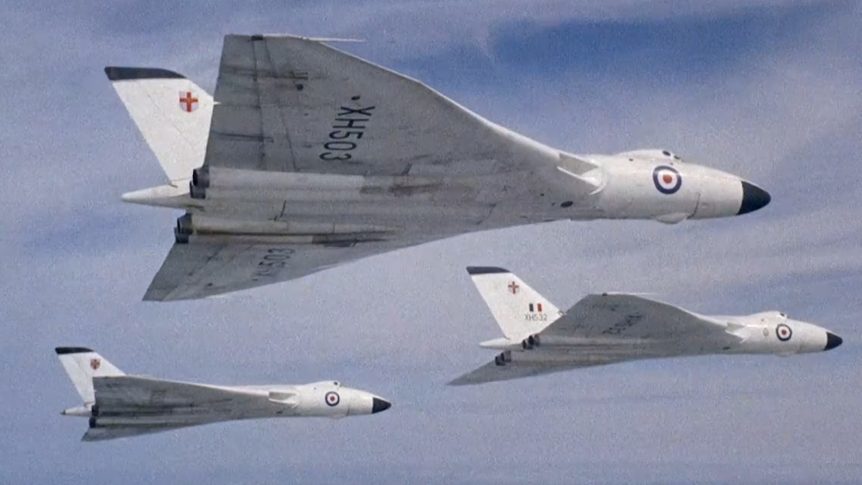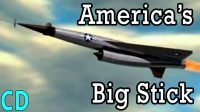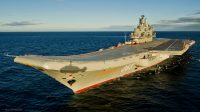It took just 11 years to go from the first flight of the Lancaster Bomber in 1941 to the first flight of the VX770, the prototype Vulcan bomber in 1952. Yet the difference between them could hardly be greater, the Vulcan along with the Victor and Valiant was a new generation of the new planes known as the “V” bombers, planes for a new era and a newly, nuclear-armed Britain.
In 1945 Great Britain emerged victorious from the Second World War: financially bankrupt but rich with engineering genius. The nation who had fought off the Luftwaffe and cracked the Enigma code and created Radar was flush with a generation of world-beating engineers and scientists who went to work at the great British aero corporations, like Hawker Siddeley, Westland and Vickers-Armstrong.
War was over, but another race was beginning, as the Americans and Soviets jostled to find a new balance of power. The price of a seat at the ‘big boy’s table’ soon became clear: an independent nuclear deterrent.
In 1947, just 5 years after the first Lancaster went in to service, the British government issued a specification for a new bomber, one that could have a range of up to 3700km, 2300 miles, cruise at 930km per hour, 580 miles per hour at between 35 to 50,000ft and carry a 5 ton nuclear bomb. Because they flew so high and fast they would be out of the range of Anti-aircraft weapons and enemy fighters and so they had no active defences like to previous generation of bombers.
By 1952, Britain had tested its first atomic bomb in ‘Operation Hurricane’, detonating a 25 kiloton device off Western Australia. But just as the British celebrated joining the nuclear club, 3 weeks later the Americans tested their first Hydrogen Bomb, Ivy Mike some 400 times more powerful.
Prime Minister Winston Churchill ordered that Britain should its have own H-bomb by 1957 and the V bombers would be the delivery system with the first H-bomb test being airdropped by a Valiant Bomber.
Back in 1947, The government put the tender out 3 companies Avro, Handley-Page and Vickers -Armstrong.
It was a demanding specification, the old designs of propeller-driven aircraft where not up to the job but the knowledge of high speed designs was equally lacking too. At Avro, based in Manchester, the company which had built the highly successful Lancaster bomber, a young engineer called Bob Lindley, turned to German swept wing research that he had seen on a trip to Germany just after the end of the war.
At first, Lindley’s design was dismissed: but upon further investigation, the ‘delta wing’ had significant advantages. By enclosing the engines in the wing structure, an aircraft could have reduced drag and high stability without too much weight. Lindley would later go to America to work on the Gemini program and the Space Shuttle. But his sketch became a reality at the all-British Avro, and was named by their technical director Roy Chadwick after the Roman god of fire: ‘Vulcan’. The delta wing design pioneered by the Vulcan would also be used on Concorde and the Space Shuttle.
But the Vulcan wasn’t the only futuristic bomber being designed by the British at the time. The UK Government also awarded a contract to Handley-Page, who had built the Halifax bomber. Their proposed aircraft, named ‘Victor’, also used an advanced wing design, described as a ‘crescent’ and like the Vulcan, had engines mounted in the wing. It was also the most technologically advanced electronic plane in the world. But the government had learnt from the war that it was better to spread the risk when dealing with new technology.
So the third contract went to Vickers-Armstrong. Selected as an ‘insurance option’, their design was considerably less advanced than the Vulcan and Victor but promised to come in under budget, and on-time. Sure enough, Vickers delivered ahead of schedule, and in May 1951 the ‘Valiant’ was the first of the three to take to the sky, putting pressure on Avro and Handley-Page to deliver.
Production models of the Valiant were delivered in early 1955, with the first Vulcan following the next year, and the Victor by the end of 1957.
When the prototypes Vulcan and Victor appeared at air shows in the early 1950’s, they were keen to show off their capability, performing barrel-rolls: a manoeuvre previously unthinkable and ‘unbecoming’ of bomber aircraft. But the ‘V bombers’ were unlike anything else the world had ever seen: they were rewriting the book on the ‘jet age’.
The V bombers not only impressed the public but also friend and foe alike. The Vulcans Delta wing gave it a high altitude performance that allowed it to turn tighter than the swept wing fighters of the day like the lightning and Mig 15. It also made other bombers like the then new B-52 look positively sloth-like in comparison.
The V bombers were invited to the US for bombing competitions. Planes would fly for hours at night to a simulated target, usually a city like Tuscan, Salt Lake City and Los Angeles. There they would drop simulated nuclear bombs, not real devices. By using electronics they could calculate the accuracy of the drop. The V bombers consistently achieved within 500 meters accuracy, whilst the B-52’s had quite a lot larger errors.
As ‘V bombers’ began arriving at RAF bases around the UK, the new squadrons went into immediate high alert.
As the Fylingdales radar scanned the skies for ballistic missiles, the procedure was for two hundred V-bombers to be in the air within four minutes: before the Soviet missiles landed. QRA, or ‘Quick Reaction Alert’ crews trained around the clock, for three levels of readiness: fifteen minutes, five minutes, and just two minutes. Under this highest alert, the bombers would sit at the end of the runway, fuelled, with engines running.
In total, 136 Avro Vulcans, 86 Handley-Page Victors, and 107 Vickers Valiants were built. All were originally painted in ‘anti-flash white’, to reflect some of the radiation from a nuclear blast. Although the ‘V bombers’ never carried out the nuclear strike mission they were designed for, the Valiant has the distinction of being the only one of the three to drop live nuclear devices, as part of Britain’s nuclear test program.
But around this time, the destiny of the ‘V bombers’ would also change. In 1957 a Defence White Paper announced that ballistic missiles would be Britain’s new nuclear delivery system. Advances in surface-to-air missiles meant that the V-bombers were suddenly vulnerable: there was no longer a ‘safe’ high-altitude. Instead, the best option would be to climb to high-level flight over Western Europe, descending to fly just above ground level through the Eastern Bloc, then climbing again just before reaching their targets. The bombers were repainted with a camouflaged upper side to fit the new mission profile.
However, the V-bombers were not built to fly fast at low altitudes, the denser air and increased turbulence caused fatigue cracks that on the Vickers Valiant which was so bad that they had to be formally retired in 1965. The Victors also suffered from fatigue problems, though not as bad, they were also withdrawn from nuclear service by 1968. As missiles replaced bombers in the late 1960s, some of the surplus Victors were converted into reconnaissance planes and refuelling tankers, leaving just the Vulcan in the bomber role.
By 1982, the first and last time that the Vulcan bombers would see active service, they about to be retired with much of their equipment looking almost as dated as the Lancaster’s they replaced in the 1950s, much of their navigational equipment being easily recognisable by World War 2 bomber pilots.
Their last mission was to bomb the Port Stanley airfield in the Falklands. This would entail the longest ever bombing run at the time: flying 7,800 miles (12,600 km) from Ascension isle to the Falklands over open ocean in ‘Operation Black Buck’. Three Vulcans where chosen with the more powerful Bristol Olympus 301 engines and supported by 11 Victor tankers flying in relays. The distance was so far that the forward Victor tankers had to be refuelled in mid-air themselves. The single attacking Vulcan used 50,000 gallons of fuel and needed refuelling five times during the missions. Seven “Black Buck” missions were planned but only five were carried out.
Even though the missions had been a success, for the Vulcans their time was up, the last ones being retired from active service in 1984. The plane that had been a technological tour de force in the 1960’s and that made the B-52 look old-fashioned, itself had become out of date and unlike the modular construction of the B-52 it couldn’t be updated in the same way.
One was kept as a display plane, XH558 and continued with the RAF until 1993. In 1997 it was bought by a private company and restored and toured the country attending air shows, this footage I shot at my local Clacton air show but in 2015 it ceased flying due to it being increasingly difficult to find the skilled service personnel and the withdrawal of support from the original manufacturers. However, it is still able to accelerate on the runway at its Doncaster Sheffield Airport base.
The Handley Page Victor, was the one which lasted the longest with the final converted tankers being retired in 1993.
The ‘V bombers’ were built to shock and amaze the world, to do the unthinkable and they did right up until their final mission.






Comments
Dear Mr Shillito,
I greatly appreciate and enjoy all your ‘Curious Droid’ videos on YouTube.
However, on one point I’m afraid I have to disillusion you, as I was disillusioned several months ago by a Polish man who responded to an online comment of mine. Britain was NOT “the nation that cracked the Enigma code”, as you claim in your introduction to your latest video on the V-bombers. That was achieved by Polish Cipher Bureau mathematician-cryptologist Marian Rejewski and his colleague Henryk Zygalski, initially in DECEMBER 1932. It was Rejewski was later invented the “bomba kryptologiczna” (=cryptologic bomb), probably in October 1938, and he had been deciphering Enigma-encoded German military messages for SIX-AND-HALF-YEARS (!) before he informed British and French military intelligence about his achievements.
As Rejewski wrote long after the war: “It was not [cryptologic] difficulties […] that prompted us to work with the British and French, but only the deteriorating political situation. If we had had no difficulties at all we would still, or even the more so, have shared our achievements with our allies as our contribution to the struggle against Germany.”
Credit where it’s due, please.
Actually, Alan Turing, working at Bletchley Park, headed the team that developed and refined the Bombe, as it was known there. He was NOT the original inventor. He was NOT the man who first cracked Enigma codes.
Claiming that Britain, in the person of Turing and his Bletchley Park associates, was “the nation that cracked the Enigma code” is a romantic, jingoistic myth that needs to be dispelled.
Why not do a Curious Droid video on the Polish Cipher Bureau? It’s a fascinating story.
See: https://en.wikipedia.org/wiki/Biuro_Szyfr%C3%B3w as a starting point for further research.
Kind regards,
Rob Stuart
Mgr. v.d. Weteringstraat 14a
3581EH Utrecht
The Netherlands
tel. +31.6.40475088
email: [email protected]
Dear Mr Shillito,
Further to my previous comment, here’s a Telegraph article I’ve just found on the pioneering work of the Polish codebreakers and how they were ignored by the makers of the film ‘The Imitation Game’, starring Benedict Cumberbatch as Turing:
http://www.telegraph.co.uk/science/2016/03/15/polish-codebreakers-cracked-enigma-before-alan-turing/
Kind regards,
Rob Stuart
mMy interest begins with National Service 1953-55 when I spent 6 mths at RAF St Athan, leaving as J/T air frames to a posting at 60 MU based then at RAF Rufforth near York.
Several detatchments found me at RAF Linton, Driffield, Middleton St George, and once to Squires Gate Blackpool to repair an Anson which had a port side undercarriage failure requiring work on u/c, port outer wing and rudder frames.
Later as a civvy with family we lived at Coleby near Waddington where I was CI at ATC Squadron North Hykeham, at the same time learning to fly from Sheffield Aero Club at Netherthorpe, my instructor being Flt Ltnt Taff Jones from nearby RAF Finningley, the aircraft for instruction being the Cessna 150. This period (1965-6) is best remembered for my solo crosscountry sortie when on a busy midweek on return leg from Skegness airfield.
I called up request entry into Military airspace to fly over Lincoln back to base at Netherthorpe circa 10 mls E, ordered inc ht to flight L3 (from L2) and had just achieved when 2 Lightnings in close formation passed under me at c. 90 degrees,
also observed was Vulcan activity at both Waddo and Scampton.
That was a flight which has remained in memory from 54 yrs ago along with the making of flying friends of that era, when they were practising low level flight of the Vulcan to equip them for the strategy which the Cold War required of them.